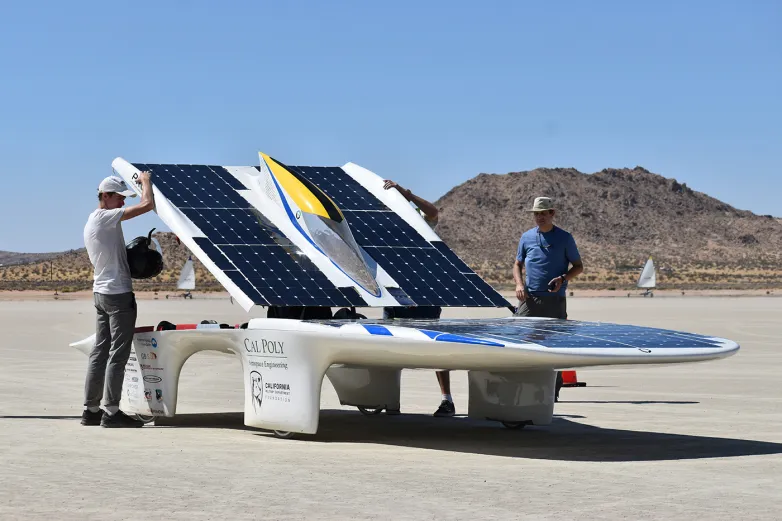Student-made solar car approached Guinness World Record speed. They are still working to take the title
- Cal Poly team members kept their eyes on El Mirage Lake’s horizon, waiting in anticipation. Just then, the futuristic vehicle they knew all too well emerged from a mirage and sped across the desert.

The vehicle, named “Dawn,” is a solar powered car built by members of the College of Engineering’s Prototype Vehicles (PROVE) Laboratory to attempt to beat the Guinness World Record for the fastest solar powered car. The solar car is funded through a combination of corporate sponsorships, individual donations and academic grants.
In August 2019, the car reached a peak speed of 51 mph, just a few miles short of breaking the world record.
A student team from Ashiya University in Japan set the world record of 56 mph in 2014. However, the PROVE team’s model has the potential to reach a top speed of 65 mph, and its members said they hope to blow the current record out of the water.
The key to achieving 65 mph lies in PROVE’s unique approach in design. Members built the car specifically to beat the record and factored certain qualifications into the design from the beginning.

In August 2019, the car reached a peak speed of 51 mph, just a few miles short of breaking the world record. PROVE Lab | Courtesy
A major parameter to qualify for the Guinness World Record states that the car cannot use battery storage–meaning renewable energy from the sun must be sent directly to the motor without being stored.
“Since we’re going directly from solar to the motor, that’s a unique challenge that we’ve had to face,” co-project manager and mechanical engineering junior Kristin Kraybill said.
The qualifying criteria gave the PROVE team unique freedom in building the car but also presented challenges.
“They didn’t say how big the car was supposed to be,” Kraybill said. “They didn’t say what it was supposed to look like or anything like that.”
Team members settled on building the car using about 600 commercial grade solar cells with a nontraditional aerodynamic shape to minimize wind resistance.
“We built everything from scratch for ourselves, both because we wanted to and because we were able to get the resources and the time to do that,” co-project manager and aerospace engineering junior Aaron Li said.
PROVE member, ‘Dawn’ driver and aerospace engineering senior Lacey Davis said she considers the attempt a success even though they did not break the record.
“Overall everything is about how we can do things safely and get the correct data,” Davis said.
The team is currently working to solve its problems. Not only were members unable to test the car on the optimal date of the summer solstice, but they also had trouble using older solar panels in the design and ensuring the car’s motor ran at an expected 97 percent efficiency level.
Kraybill and Li said they expect to resolve these issues in time to return to El Mirage Lake and beat the speed record in summer 2020.
Also read


